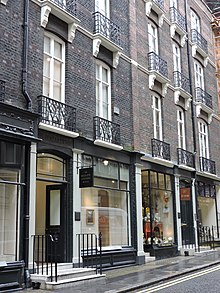Bury Street, St James's

West side of Bury Street
|
|
| Length | 0.16 km (0.10 mi) |
|---|---|
| Location | St James's, London, United Kingdom |
| Postal code | SW1 |
| Nearest Tube station |
|
| Coordinates | 51°30′25″N 0°08′19″W / 51.506930°N 0.138615°WCoordinates: 51°30′25″N 0°08′19″W / 51.506930°N 0.138615°W |
| North | Jermyn Street |
| South | King Street |
| Other | |
| Known for | Art Galleries and Restaurants |
Bury Street is a one-way street in St James's, London SW1. It runs roughly north-to-south from Jermyn Street to King Street, and crosses Ryder Street.
Probably taking its name from Bury St Edmonds, Rushbrooke, the country seat of the Jermyn family, was near that town, and from 1643 until his advancement to an earldom in 1660, St. Albans was Baron Jermyn of St. Edmundsbury. The street first appears by name Berry Street in the rate books of St Martins in 1673, 11 names were recorded.
On 23 February 1755 Horace Walpole described a fire in Bury Street. A newspaper at the time reported: "Yesterday morning [20 Feb.], about five o'clock, a fire broke out at Mr Thompson's, an embroiderer in Bury Street, St James's, which entirely consumed the same, and damaged several other houses adjoining" (The Daily Advertiser, 21 February 1755).
The freehold of the street belongs to The Crown Estate.
Notable residents have included writer Jonathan Swift, writer and politician Richard Steele, William Brummell father of Beau Brummell, the statesman Charles Jenkinson, 1st Earl of Liverpool, Irish poet Thomas Moore and poet George Crabbe.
In Swift's A Journal to Stella, he wrote "Tomorrow I change my lodgings to Bury Street". (Letter 3, London, 9 September 1710).
There are two listed buildings in Bury Street:
There are also the Economist Buildings, which occupy an area from St James's Street to Bury Street (Nos 28–30d), London, SW1. Built by Alison and Peter Smithson between 1962 and 1964, in the New Brutalist Style.
...
Wikipedia
